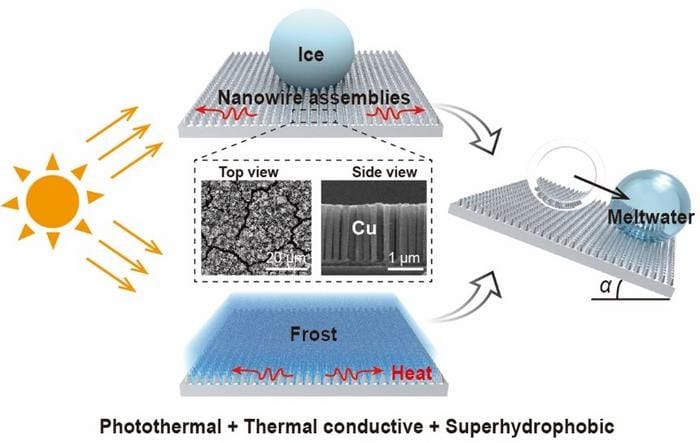
A passive coating that is almost 100% effective at removing ice and frost from surfaces has been unveiled by researchers in China. The team’s design features an array of copper nanowires that combine excellent photothermal, heat-conducting, and superhydrophobic properties to achieve a very high defrosting efficiency.
The coating was developed by Siyan Yang and colleagues at the Dalian University of Technology, City University of Hong Kong and The Hong Kong Polytechnic University.
The build-up of ice on cold surfaces can pose problems in a wide range of situations from cryogenic freezing to aircraft wings. While a variety of techniques have been developed to remove ice and frost, they all have shortcomings. “Traditional de-icing and defrosting solutions mainly rely on mechanical, thermal, and chemical approaches, all of which are either energy-intensive, labour-intensive, or environmentally unfriendly,†Yang explains. “Additionally, some of these active approaches required direct contact with the material surface, posing risks to delicate coatings.â€
Passive approaches
More recently, de-icing and defrosting technology has seen a shift towards passive approaches, which involve modifying material surfaces to prevent ice from forming and building up. This often involves designing slippery, hydrophobic, or even phase-changing surfaces. These can reduce the force required to physically remove ice and frost, or prevent water droplets from adhering and freezing in the first place.
One particularly promising advance has been the development of photothermal coatings that convert sunlight into heat – thereby melting ice and frost, even in freezing conditions. However, this technology has been held back by the limited thermal conductivity of existing coatings. This results in uneven heating, and strong interactions between surfaces and water droplets leading to uneven rates of meltwater removal – with both limiting defrosting performance.
Now, Yang and colleagues have designed a new type of surface that addresses these challenges. The surface features an array of copper nanowires that are assembled using a simple electrodeposition method. According to the team, their design combines excellent photothermal, heat-conducting, and superhydrophobic properties in a single material.
Upright and hydrophobic
The highly-ordered pattern of nanowires is very good at absorbing sunlight – and the high thermal conductivity of copper allows the captured heat to spread quickly and evenly throughout the entire array. Among the nanowire patterns that the team created was an arrangement of upright nanowires, separated by microgrooves about 2–3 micron across. This structure made the surface extremely hydrophobic: allowing meltwater to drain off evenly.

Ice crystals jump off surfaces in new electrostatic de-icing technique
“Through wettability and photothermal tests, we found that most of nanowire assemblies can be treated as superhydrophobic, with a sunlight absorption rate larger than 95%,†explains team member Qixun Li. “Because of the high conductivity of copper materials, nanowire assemblies enable excellent de-icing and defrosting performances.â€
The result is that close to 100% of ice and frost is removed from the surface, which the team says is the highest defrosting efficiency ever achieved on a passive surface.
For now, the team’s design is not suitable for practical use. Their nanowire arrays have a limited durability, are vulnerable to chemical damage, and remain difficult and expensive to produce on larger scales. However, the researchers hope that by building on their results, further research could soon lead to materials with a similar defrosting performance a step closer to a commercial rollout.
The research is described in the International Journal of Extreme Manufacturing.


